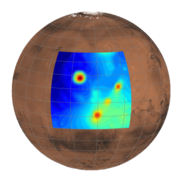 It's just about physics,
planets... and computers!
It's just about physics,
planets... and computers!
Simulations results
Here are some numerical results and animations. When needed, .zip or .txt files contain all the information and references needed to read and use these results.
Comments are welcome.
I hope thes simulations are useful to your research or for outreach.
Contact me for specific requests.
2015
New spin on thermal tides!
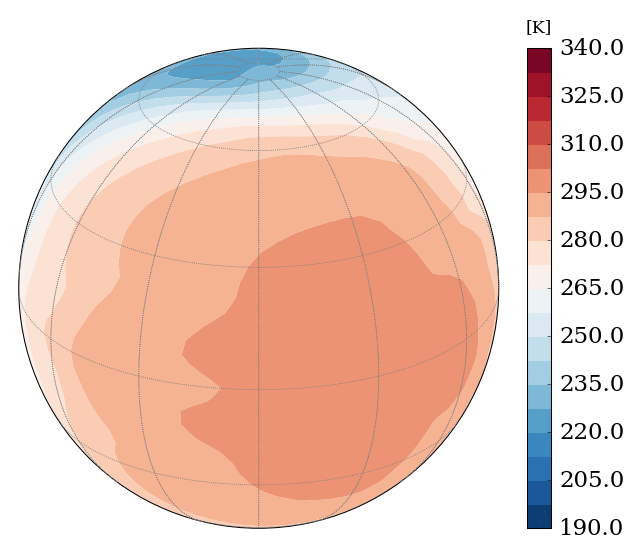
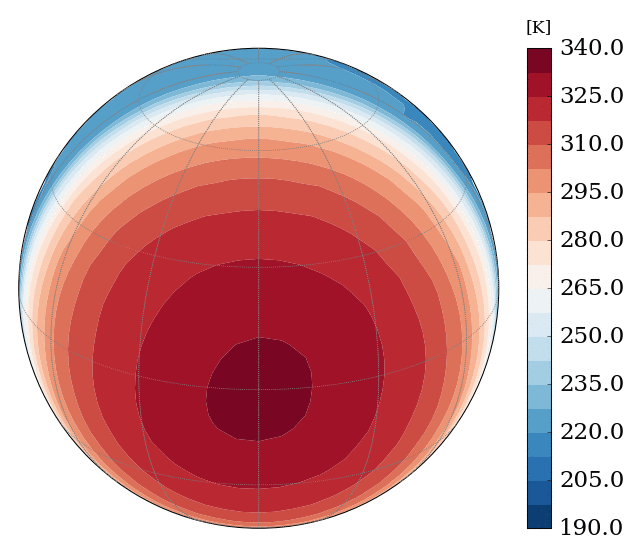
Temperature at the surface of a planet with (asynchronous; left) and without (synchronous; right) diurnal cycle. In the synchronous case, because the planet rotates on itself as fast as it revolves around its star, the sunlit region does not move at the surface (materialized by the gray meridians that rotate slowly as our viewpoint turns around the planet). In the asynchronous case, the rotation of the planet is faster. Thus, the hot region, which is beneath the star, moves from left to right (east to west, as on Earth). Thanks to the thermal inertia of the ground, there is a hot trail following the hot spot that enables the night side to remain temperate. On the contrary, the entire night side of the synchronous planet, which is heated only by the winds coming from the hot hemisphere, reaches temperature rarely seen at the poles on Earth. These movies are the result of simulations for a planet having the same atmosphere and receiving the same insolation as the Earth.
2013
Moist Climate Bistability on Tidally-Synchronized Landplanets
If the water inventory is limited on a planet, so that there are no global oceans at the surface, atmopheric water transport eventually dominates the water budget. As a result, the hydrological feedback on the climate works very differently on a landplanet that on an (almost) aquaplanet like the Earth.
The reason is that, on Earth, hot regions are also humid because it is where solar-powered evaporation is most efficient. And even if the atmospehre naturally transports water vapor from these hot, moist tropical regions toward the midlatitudes and poles, the oceans keep redistributing the water evenly. On a landplanet, however, the oceans are not there to play this role. Water thus keeps accumulating in the colder regions of the surface (i.e. the poles or, in the specific case of planet whose spin is synchronized with the orbit, the resulting permanent night side). This can result in a so-called "collapse" state where all the water has collapsed in a permanent, thick ice-sheet.
Interestingly, even if the same conditions are met, this "collapse" state is not the only possible climate regime for the planet. Indeed, if the planet started a little bit to hot, or with a little bit too much water vapor, the resulting greenhouse effect can be so strong that it eventually triggers a "runaway" instability: the planets surface warms, increasing evaporation, and thus greenhouse effect. In the end, the whole water ends up vaporized in the atmosphere and the surface is much hotter.
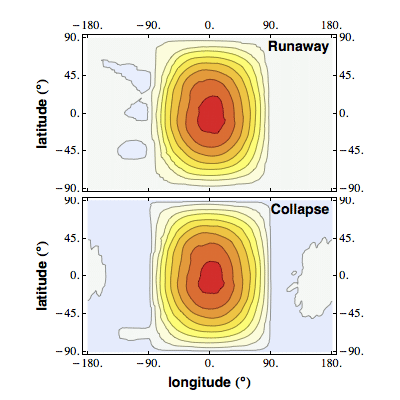
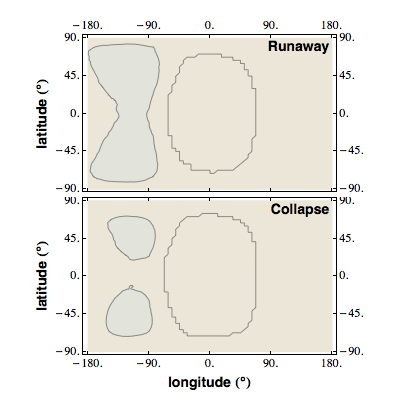
Here are the results of two simulations for a locked planet with the properties of Gl581c. The left panel shows the temperature distribution (in K), and the right panel the normalized amount of water at the surface (liquid+ice; kg/m2). The upper row shows the experiment where there was just enough water vapor to trigger the runaway greenhouse instability, and the lower row shows n experiment where all the water collapses. The day side is between -90° and 90° longitude. The duration of the simulation is about 1000 Earth days
2011
Distorted Transiting Planets
As it is well studied in the solar system, our giant planets are flattened by the centrifugal force created by their fast rotation. As most transiting exoplanets are extremely close to their host stars, they exhibit the shape of a triaxial ellipsoid due to the interplay of rotation and tidal interactions.
As shown in Leconte et al. 2011, this distortion can be computed analytically, provided that some parameters describing the internal structure are known (Polytropic index, Radius...) Here are grids of numerical structure models giving the radius, polytropic index, Love number, moment of inertia, effective temperature... for gaseous objects with solar composition as a function of mass, age and incoming irradiation (Planets_2011.zip).
2010
Radius Anomaly
A large number of Giant planets observed by transit show a larger radius than predicted by standard evolution models including the effect of the strong irradiation received by the atmosphere.
Here is a table (RadiusAnomalyList.txt) quantifying this anomaly with our evolution numerical code (Leconte et al. 2009, Leconte et al. 2010a) for the planetary parameters taken from exoplanets.eu.